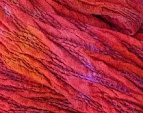I am also showing two pieces of wall art in the Cloak exhibition, part of my Cloaked in Feathers series.
Since
earliest times Feather Cloaks have been worn. Druids and Shaman, the
central figures of an ancient clan's magical and religious life, are
recorded as having the power to transform themselves into different
forms, in particular the bird. Bards, Druids and Shaman also wore
very colourful cloaks made from the skins of birds.
In
traditional Maori culture many birds were seen as chiefly and the
korowai or feather cloak is still used as a sign of rank and respect.
I
am weaving this series to share the beauty of our native birds of New
Zealand so people learn to treasure and protect them, hopefully
avoiding any more species from going extinct.
Takahe
The
flightless takahe is a unique bird and a survivor. Even though the
takahe remains on the critically endangered list it has clung to
existence despite introduced preditors, hunting and habitat
destruction.
The
Takahe was believed to be extinct until it was rediscovered in 1948.
Its night cry was described by Maori as the sound of two pieces of
ponamu being struck together.
Tui
The
Tui,
endemic to New Zealand, are boisterous, medium sized, common and
widespread birds of forest and suburbia. They look black from a
distance but in good light tui have a blue, green and bronze
irridescent sheen and distinctive white throat tufts (poi).
Adults
have a notch on the 8th primary feather and this feather quivers from
the narrow part creating the whirring sound common in flight. They
have a noisy unusual call but can also replicate human speech.
Tui
are notoriously aggressive and will defend a flowering or fruiting
tree from all comers. They vigorously chase other birds away
from their feeding territory.



No comments:
Post a Comment